
Undoing The Damage of Teen Talk Barbie
For the most part the content of this talk is unedited. I've added screenshots of the slides and links to provide context where needed. Please excuse any typos you may encounter, I promise they were corrected on the printed version I used during the speech. Check out the cited source post, if you'd like to dive deeper on anything you see here.
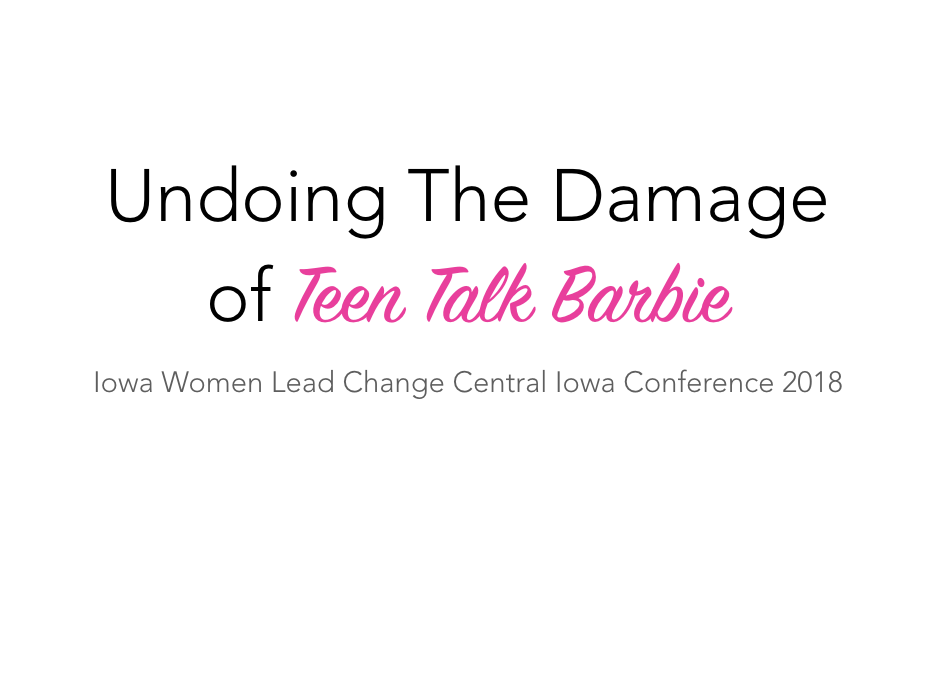
For a moment, let’s all step back to 1992. Honey I Blew Up The Kid is the number 1 movie in America. Bill Clinton is running for President. And Sir Mix A Lot’s Baby Got Back tops the charts.
In July, Mattel releases the first Barbie to talk since the 70s with this commercial.
Play Commercial - 30 s
In the following months, controversy follows. One of the 4 phrases that Teen Talk Barbie could say was “Math Class is Tough”. This lead the American Association of University Women, an organization that released a report in 1991 titled “How Schools Shortchange Girls”, to condemn Mattel for manufacturing a doll that could discourage girls and lower their confidence in their own math abilities.
The backlash led to this article by Bob Greene of the Chicago Tribune. I’m going to highlight a few of the more interesting quotes from the article.

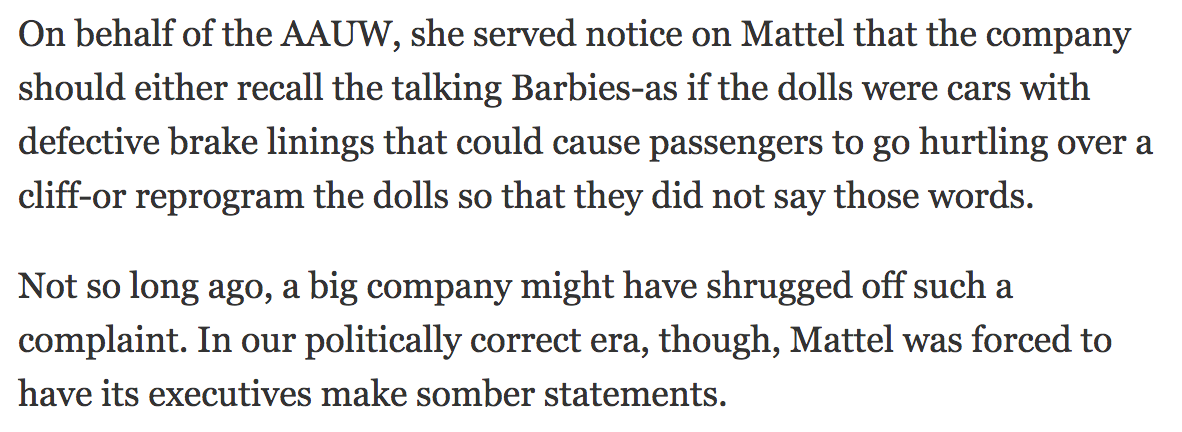

Which in turn led to this rebuttal from Mary Ellen Smyth, President of the AAUW.


[QUESTION] Since we’re in 1992, I’m asking you. What do you think about all of this?
And finally in true American pop culture fashion, 2 years later in season 5 episode 14 of the Simpsons episode titled Lisa versus Malibu Stacy, the Teen Talk Barbie controversy is parodied when Lisa’s Malibu Stacy doll says sexist phrases.
Play Simpson Clip - 50 s
Only about 1.5% of the dolls sold said the phrase “Math Class is tough”. In a 1992 article published by the Washington Post, Barbie spokesperson Lisa McKendall says that the 270 phrases spoken by Teen Talk Barbie were chosen after careful research involving “interviews with thousands of children and test marketing on thousands more”. In the same article McKendall said “Teen Talk Barbie —is merely reflecting the mind-set of Little Girl America.”
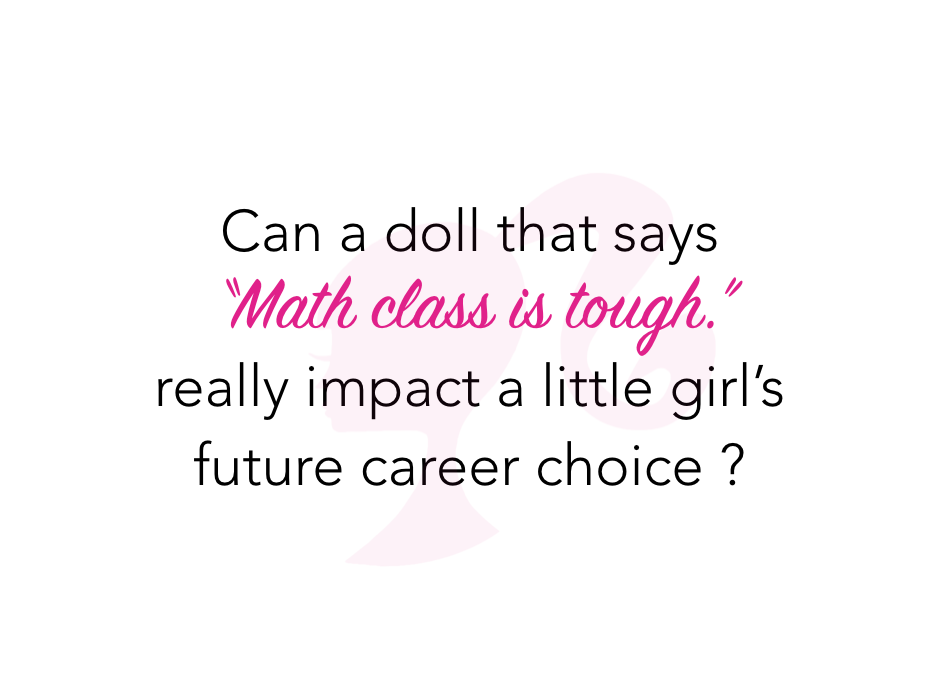
Before we can address the question, we need to be break down the different components of this issue. Gender, Barbie, and the gender gap. We will begin by talking about what it means to be feminine, followed by Barbie and her cultural significance, and finally the gender gap. In order to understand the significance of dolls, their relationship to children, and how that impacts their ability to envision themselves in certain careers, we must first understand gender identity and its development in young girls.
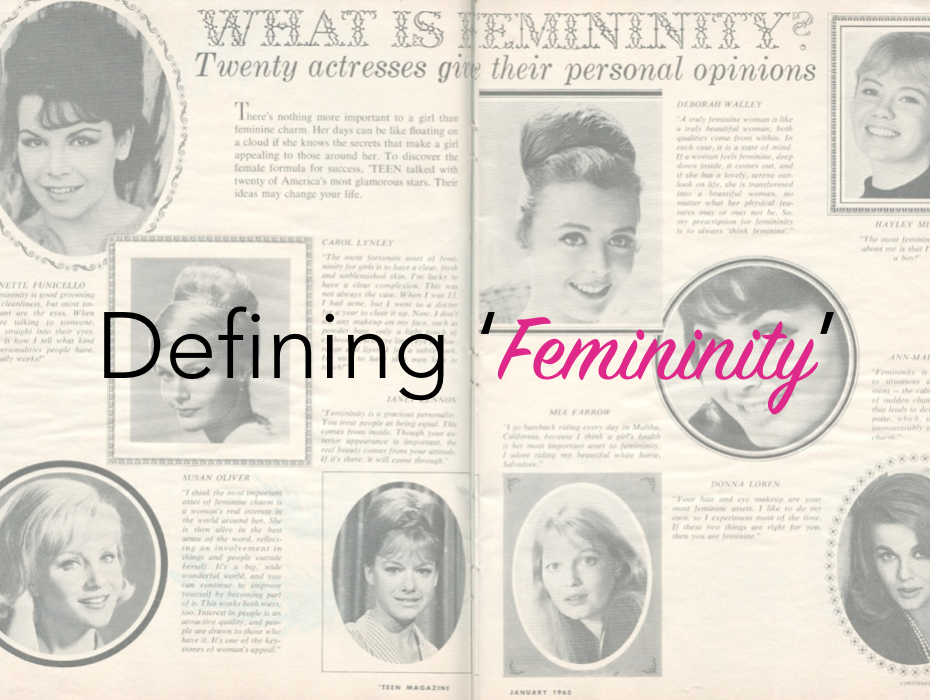
[QUESTION] So now I’m asking you, how do you define femininity?
In 1965, Teen Magazine asked 20 actresses what femininity means to them. A couple of highlights from this spread are:
Mia Farrow — “I go horseback riding every day in Malibu, California because I think a girl’s health is her most important asset to femininity. I adore riding my beautiful white horse, Salvadore”
Sandra Dee (known for Gidget and Imitation of Life) — “You must be meticulous in your clothing, make up, skin — to be clean, fresh and nice all the time”
Jane Fonda — “Femininity is knowing how to listen — men love it”
In the paper, Traditional Masculinity and Femininity: Validation of a New Scale Assessing Gender Roles, traditional femininity is defined as “relatively enduring characteristics encompassing traits, appearances, interests, and behaviors that have traditionally been considered relatively more typical of women”
[QUESTION] Can we all agree on this definition?

[RAISE YOUR HAND IF YOU OWNED A BARBIE DOLL AS A CHILD]
If your hand is up you are not alone. In 1998, it was estimated that the average American girl owns eight Barbie dolls.
Barbara Millicent Roberts was created in 1959 by Ruth Handler, wife of Mattel’s cofounder Elliot Handler. Before Barbie, little girls mostly played with baby dolls and paper dolls. But Ruth noticed that her daughter, Barbara would some times give her paper dolls adult roles and that began the idea of a doll modeled after a German doll called Bild Lilli.
Initially, it was thought that Barbie would fail. Little girls wouldn’t want to play with a doll that had the body of a grown woman. How would they be able to relate to it? But, when Barbie was released she was an instant success and soon became a sensation for young girls around the world. She was also at the center of various controversies, as previously exampled. There are many who dislike Barbie because of the unrealistic dimensions of her body and the potential for her to cause body image issues in young girls and the lack of diversity in the doll’s physical features such as skin tone, and her heritage.
According to a paper entitled “Barbie as a Model of Gender Nontraditional Career Possible Self Content for Preschool and Kindergarten Girls”, Barbie serves as a social learning model used by young girls to learn and model gender-typed behaviors and activities. The actions Barbie takes can both limit or expand the range of possible selves a young girl can envision for herself. This particular type of conditioning is called social cognitive theory which argues that children develop gender identity through their environment and social behaviors and highlights the importance of learning gendered information through models. In other words, Barbie helps little girls develop a feminine gender identity.
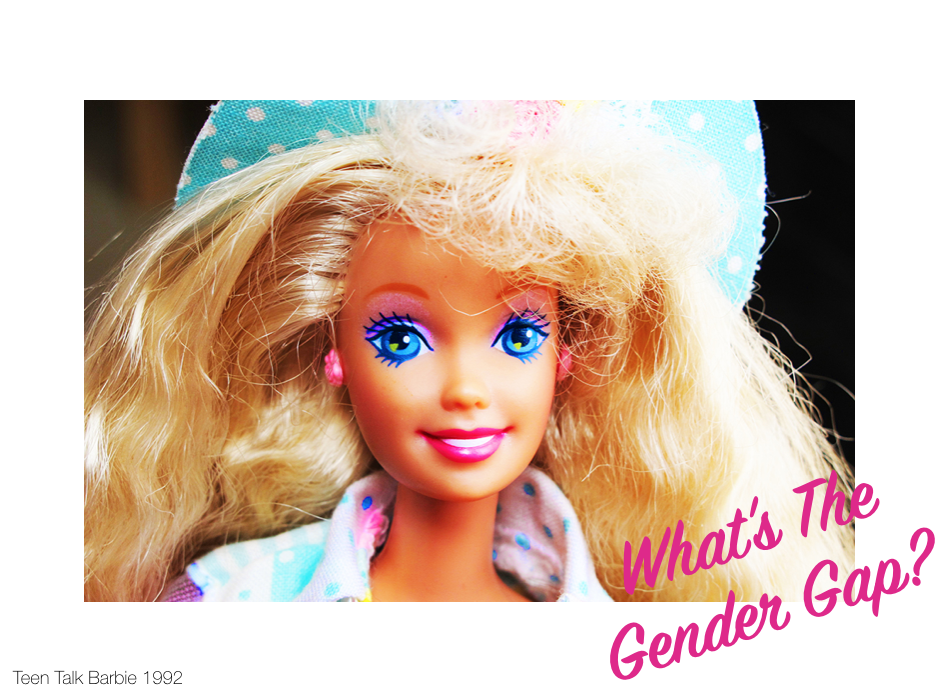
Before we go further into how Barbie’s impact on young girls can affect tech we should talk about the gender gap.
The gender gap refers to the disparities in the percentage of women who major and earn degrees in Computer Science. As of 2015, women earned 18% of the Bachelors degrees in Computer Science in the United States. I’m not sure when the gender gap in computer science was first noticed but research papers on the subject go as far back as the late 80s. The gender gap in STEM differs across each discipline and even further for different countries. In STEM, math and many of the sciences are closing their gaps as the number of women enrolling in those programs and graduating with degrees continues to rise. Meanwhile, computer science and engineering are still being left behind. In other countries, the motivations and reasoning behind the gender gap in tech differs based on culture. For these reasons, this talk focuses mainly on computer science and engineering in the United States.
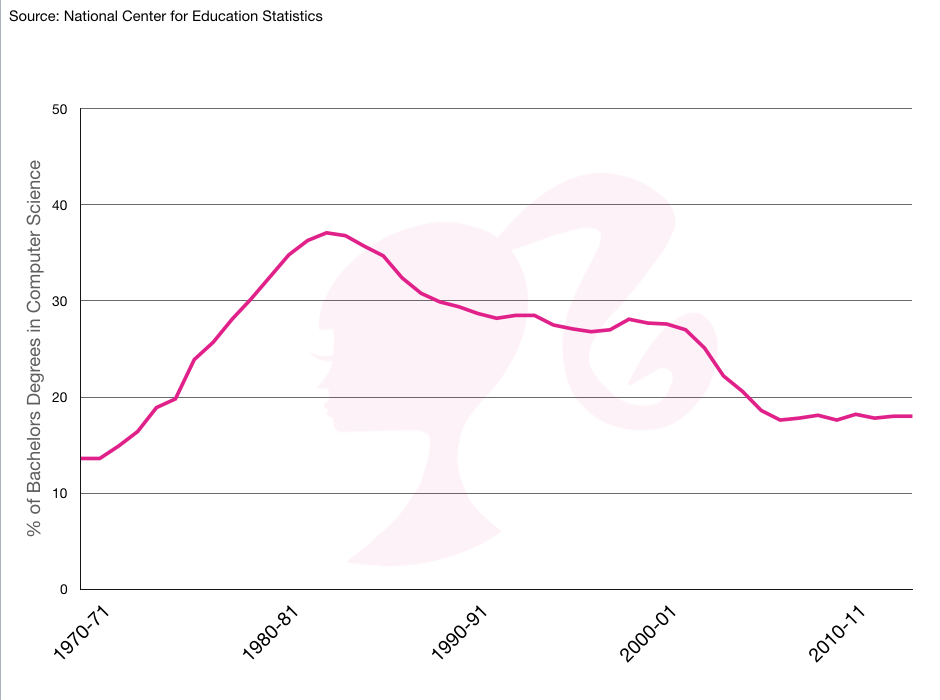
This graph was created with numbers from the National Center for Education Statistics. Researchers point to 1985 as the year where the number of women enrolling in computer science programs began to decline drastically. From there, the numbers continued to fall while the number of men enrolling in computer science programs rose.
There are many who speculate about why the gender gap exists, including the well known trope that women just aren’t interested in computer science. Since this talk focuses on examining how Barbie impacts a young girl’s decision to later study Computer Science, I will be examining the reasons laid out in “Why are some STEM fields more gender balanced than others” since it focuses on academic participation. According to this research, the three overarching factors are “a masculine culture of computer science and engineering…that signals to women a lower sense of belonging than men”, “insufficient early educational experience in computer science and engineering” which I’ve summed up to be ‘exposure’, and “larger gender gaps in self-efficacy in computer science and engineering”. We will examine each of these three factors and then discuss how Barbie has helped or hurt those factors in young children who look to her as their social learning model for gender identity.
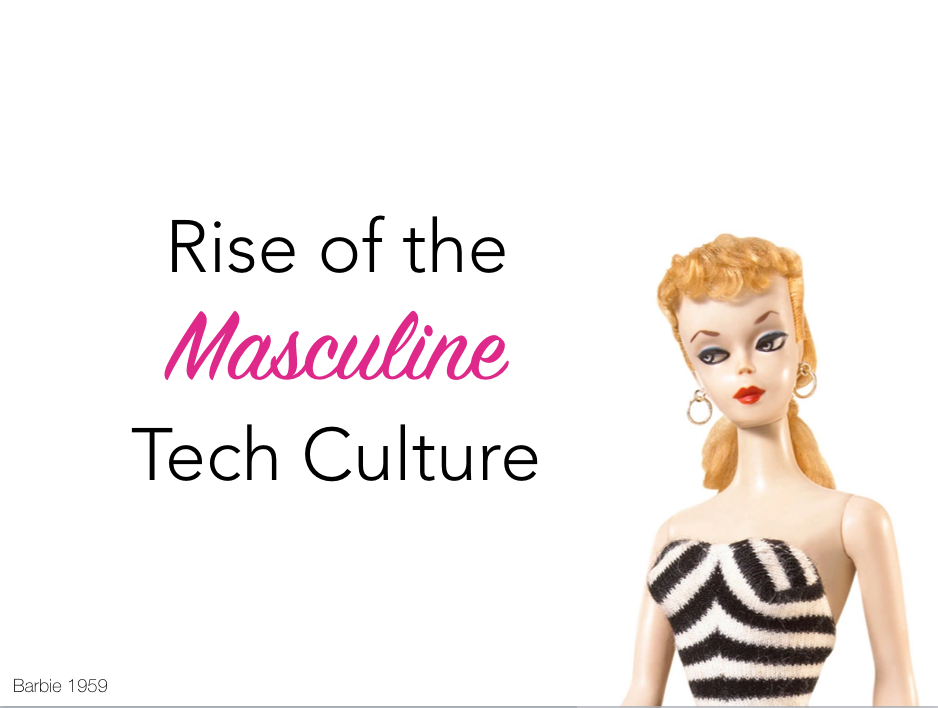
Masculine culture is described as features of a field that can cause women to feel a lower sense of belonging or be less successful than their male counterparts. A masculine culture doesn’t necessarily mean that all women are repelled and all men are attracted to it. Some women may be more attracted to fields with masculine cultures and some men may be repelled by it. However, computer Science was slowly transformed into a masculine culture. While many point to the 80s as the catalyst for the gender gap, the decades before it laid the groundwork for the transition to a masculine culture. In 1970, when the first government statistics on the computing profession appeared, women made up 22.5% of the workforce. For comparison, in 1983 women made up 32.5% of the computer programming workforce and 29.5% in 1995. In 2017, women made up 21.2%. In his paper, “Making Programming Masculine”, Nathan Ensmenger, a computing historian, discusses an article that appeared in the April 1967 issue of Cosmo titled “The Computer Girls”
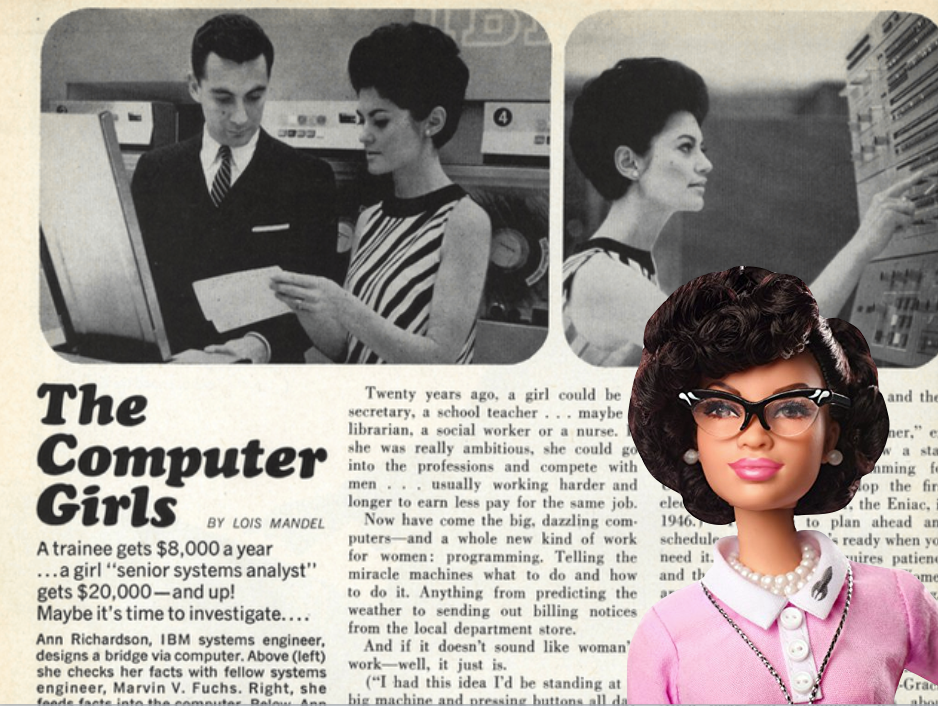
In his paper, Ensmenger said this to describe the article “It reflects very accurately the confusing—and often contradictory— messages about the proper role of women in the computing fields. On the one hand, women did play a critical role in early computing, particularly in computer programming. Compared to most technical professions, computer programming did remain unusually open to females. But on the other hand, in the late 1960s the computer programming community was also actively making itself masculine, pursuing a strategy of professional development that would eventually make it one of the most stereotypically male professions, inhospitable to all but the most adventurous and unconventional women.”
There are two interesting points to note here:
The openness of the field to women and the critical roles they played
A strategy of professional development in computer programming turned the field masculine
In the late 1960s, there were estimations that by 1970 there would be a need for as many as 650,000 computer programmers. Similarly to today, there was a shortage of computer programmers and the need was only going to get bigger. Computer programming at the time offered low-barriers to entry and subsidized technical education, making it appealing to women who otherwise would be stuck in traditionally female occupations. Many companies used aptitude tests to determine who had programming potential and those tests weren’t gender specific. One woman was quoted saying “a girl’s best bet is to get a spot anywhere in the computer department, using skills like filing or typing or accounting, with the plan in mind to get on the firm’s programmer-trainee list from the inside”.
One of the more well known examples of the critical roles that women played in computing comes from the 1940s with the ENIAC or Electronic Numerical Integrator and Computer machine at the University of Pennsylvania. The ENIAC is known as one of the first early electronic computers and was operated by the “ENIAC Girls”, a group of six women; Kathleen McNulty, Frances Bilas, Betty Jean Jennings, Betty Holberton, Ruth Lichterman, and Marlyn Wescoff. Due to their intimate knowledge of the ENIAC, the women could diagnose problems and troubleshoot with the same proficiency or better of an engineer. The idea during this time was that the development of hardware was the core business of computing while software programming was a secondary, low tier task. By and large, the job of “coder” was considered work for women while men were considered the planners or engineers who did the intellectual work.
Ensmenger summed up the legacy of women in computing very well when he stated:
“It wasn’t that women were uninterested in computing, or unprepared or constitutionally disinclined to participate…but rather that their participation has been systematically ignored or under-reported”
So, How was the field made masculine? Ensmenger points to psychological profiles and the professionalization of the field.
In the late 1960s, two psychologists with the System Development Corporation developed a detailed profile of who a computer programmer is and what their interests are. Most notable of the traits they described was a lack of interest in other people, specifically a disinterest in activities involving close personal interaction. In another study, the psychologists found this to be truth of women programmers too. Thus, the famous idea that computer programmers lack “people skills” was born. Many of the other traits associated with computer programmers were masculine characteristics.
Also during this time, in a strange irony given the drastic need for software programmers, the market was oversaturated with aspiring programmers with little training and no practical experience. To combat this, companies moved to professionalize the field which meant creating qualifications and standards for computer programmers to assure basic standards of quality and reliability. In theory that sounds like a good idea but many of the aspects of professionalization imply masculinity. Ensmenger cited several examples of this.
Professionalization imposed a requirement for formal education which affected women who chose to take time away for children.
Professionalization created certification programs and licensing requirements that disproportionately affected women. Ensmenger notes that in 1965, the Association for Computing Machinery imposed a four-year degree requirement for membership. A survey from the late 1970s showed that fewer than 10% of ACM members were women.
Professionalization suggests a degree of managerial authority and competence which are traits associated with masculinity. It was commonly believed that female programmers were incapable of leading a group or supervising their male colleagues.
Professionalization requires segmentation and stratification. Ensmenger points out that the job category of “programmer” was a blanket term used to describe a broad range of titles. Professionalization brought forth a complicated hierarchy of job titles that differentiated between senior, junior, and lead programmers or analysts. There’s evidence that suggests that women often held the jobs at the lower end of the hierarchy.
A mixture of the psychological profiles and professionalization that marginalized women laid the foundation for the tech industry eventually becoming normalized as male.

This is Game Developer Barbie from the Barbie Careers line. She was released in 2016 and has real java code on her computer. This isn’t actually anything wrong with Barbie’s representation of her, she’s here as a symbol of how far the perception of gamers has come.
The 1980s saw the creation of tech culture as we know it today in a colloquial sense. With the rise of the personal computer, the 80s introduced the stereotypes that described the ideal software programmer in 1960s aptitude tests to popular culture through marketing, movies, and toys.
Before we talk about 1985, let’s go a few years back and talk about 1983; the year of the video game crash. The video game crash was caused by the over saturation of the video game market with subpar games and consoles. Eventually buyers lost confidence in the market and a once booming industry collapsed. In response to the video game crash, companies began hiring marketing teams to do research on their demographics in an effort to understand who was buying video games so that they could market and sell to a specific demographic. This research, where correct or incorrect, stated that boys were the primary consumers of video games. With this market research, two things happened that would later heavily influence the culture of tech that we all know today. 1. The personal computers released during that time weren’t very powerful and could be used for basic word processing and game play. Since the gaming industry was in a vulnerable state, companies selling personal computers marketed their products to boys and their dads. In 1983, Caleco stated this during their announcement for their personal computer to boos from the crowd. (Video is in link. It's funny.)
And that announcement resulted in commercials that looked like this.
[PLAY COMMERCIALS]
https://www.youtube.com/watch?v=U-dmEFOT3FY
https://www.youtube.com/watch?v=iS8WBOZcHhQ
https://www.youtube.com/watch?v=CLvu3DH32CI
In fact, most of the commercials for personal computers during this time features men or boys at the center and if girls or women were in the commercial it was because the computer was advertising a family pack, talking about it being used in a classroom for educational purposes, or she was there for sex appeal.
Why is this important? Since personal computers were sold as a platform to play games on and the gaming industry shifted towards focus on a male audience, by the time girls and boys reached college a large portion of the male population already had experience with coding while many of the girls were left feeling like they were behind.
Today, the problem of exposure is different. You no longer need to be able to code in order to get your computer to work and run programs. Now we all have incredibly powerful computers at our finger tips with cell phones and tablets and in some cases, even your Alexa is more powerful computer than the ones sold in the 80s.
Now we need intentional exposure for all children to prepare them for a major or career in computer science. This means more computer science curriculum in the schools and better participation in AP computer science courses.
In 2013, Barbara Ericson from GA Tech broke down the numbers from the 2013 AP exams and found the following:
No females took the exam in Mississippi (1 exam taken), Montana (11 exams taken), and Wyoming (no exams).
Wyoming had nobody take the AP CS A exam in 2013. They had 35 students take the exam in 2001.
Mississippi had only 1 person take the AP CS A exam in 2013. But, they had 40 students take it in 1999.
For states that had some females take the exam the percentage female ranged from 3.88% in Utah (4 out of 103) to 29% in Tennessee (73 out of 251). However, 30 of Tenn females can be attributed to a girls only school that offers AP CS A.
The lack of early exposure to computer science means that many are left to depend on popular culture for an understanding of what computer science is and who studies it. Most likely that image is male and when it’s not it’s a very limited representation of female. Leading us to…
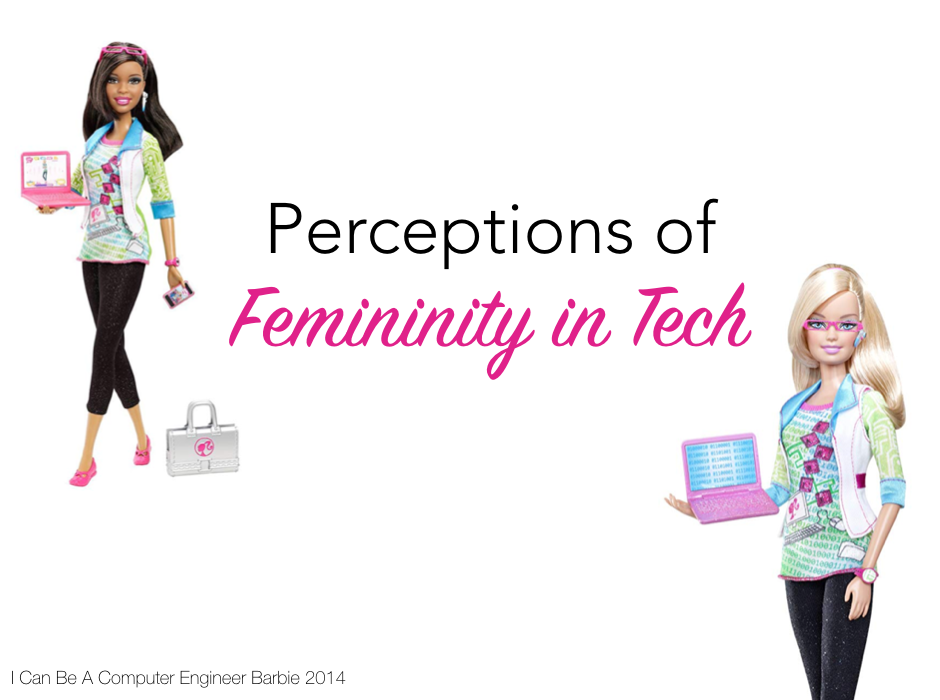
Last year, Google fired a man named James Damore for what is now infamously known as the Google Manifesto. The manifesto was a long diatribe that condemned Google for its diversity efforts and proposed that women were biologically less competent in technical fields.
During this time, an old trope bubbled to the top of everyone’s mind. Are girls just natural bad at math and inept at tech? The answer is no. In fact, research from 2015 found that girls are outperforming boys worldwide in 70% of the countries they studied. There isn’t anything to suggest a lack of natural ability, but there is research to support what is called stereotype threat. Stereotype threat is the phenomenon in which members of a stereotyped group worry that their performance on an evaluative task will be judged according to a negative stereotype indicating inferiority in the domain. For example, a study found that women taking a math test had poorer performance when they were told the test was diagnostic of math ability than when they were told the test was not diagnostic. In a diagnostic testing situation, women performed poorly because they feared con- firming the stereotype that “women are not as good at math as men”; when women were told that no gender differences have been found on a math test, the women performed better than when no such information was given.
But I brought it up because those perceptions, whether true or false, affect popular culture, the way the women in tech are presented, and the way young girls perceive themselves and their place in tech.
This is Software Engineer Barbie. The doll herself isn’t a problem, per se, but she came with a book titled “Barbie’s I Can Be A Software Engineer”. The spirit behind this book came from a good place but it perpetuates stereotypes that women in tech fight on a daily basis. Here are a few of the highlights from the book.
[Go through book pages]

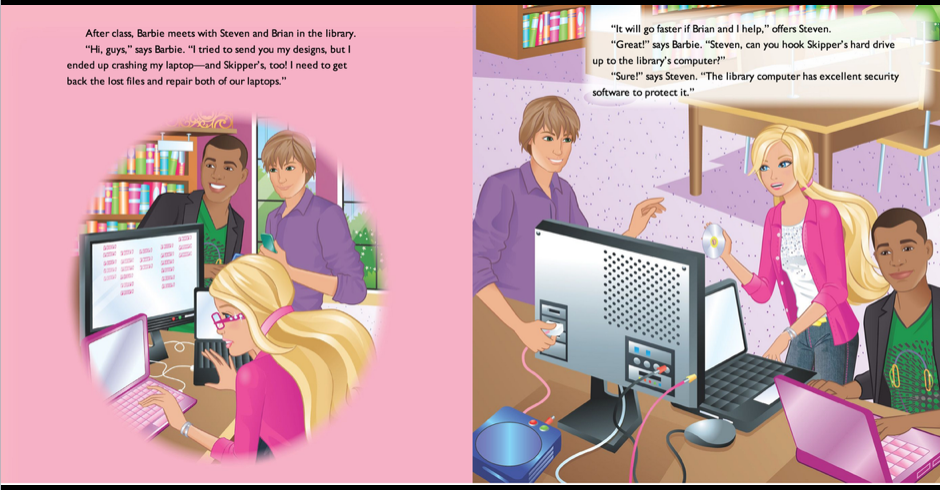
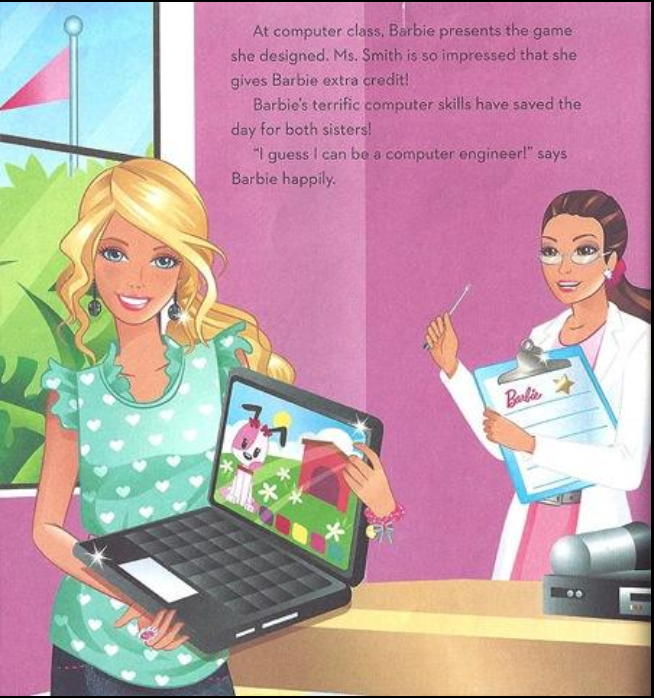
You’re probably wondering how the public reacted. Well..

Like Teen Talk Barbie, outrage followed the release of this book. Many wondered in Mattel even bothered to speak with a real computer engineer when it was written and the answer is “kinda?”. The author of the book is Susan Marenco who was formerly employed by Microsoft Development Center Copenhagen as an editor and usability designer specializing in linguistic usability. She says her assignment was to write about Barbie as a designer but she still regrets that she let stereotypes slip into the book.
Mattel has since discontinued the book but the screenshots will live on forever.
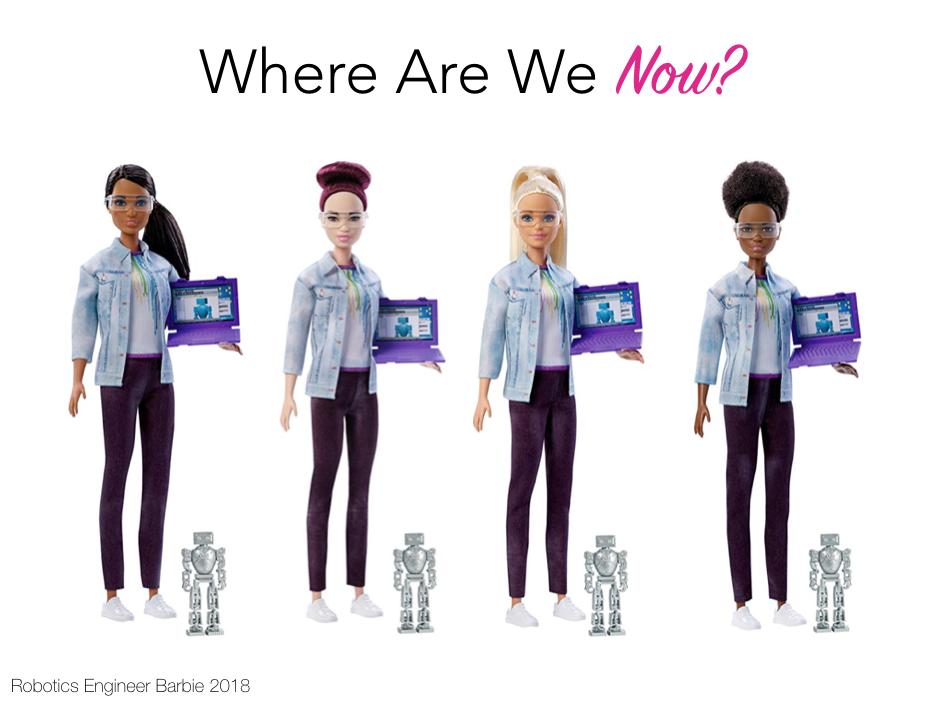
Well, as far as toys go, we’re getting better. Robotics Engineer Barbie was released this year and let’s take a moment to really talk about it. First there is a range of variety in the doll that would have existed even 5 years ago. Can anyone guess why this matters?
In the small study on the impact of Barbie in Non-traditional career clothes, the researcher found that many of the non-white children didn’t identify with dolls because of their skin tone while many of the white children pointed out things like hair color. A full range of skin tones and hair textures allows little girls of various backgrounds to see themselves in the doll which leads to them being able to use her as a social learning model, something that wasn’t always possible before. Barbie also started the Barbie Global Advisory Council in 2015 where 12 people serve 1 year terms to steer the brand into the future. it doesn’t hurt that council members receive $10,000 for their service. The Barbie Council includes many male and female experts from varying STEM-related field and their influence shows. Post-2015, Barbie gave us Game Developer Barbie and Robotics Engineer Barbie, two dolls that provide a more realistic view of what women in engineer and computer science look like… people who present a full range of feminine and masculine traits.
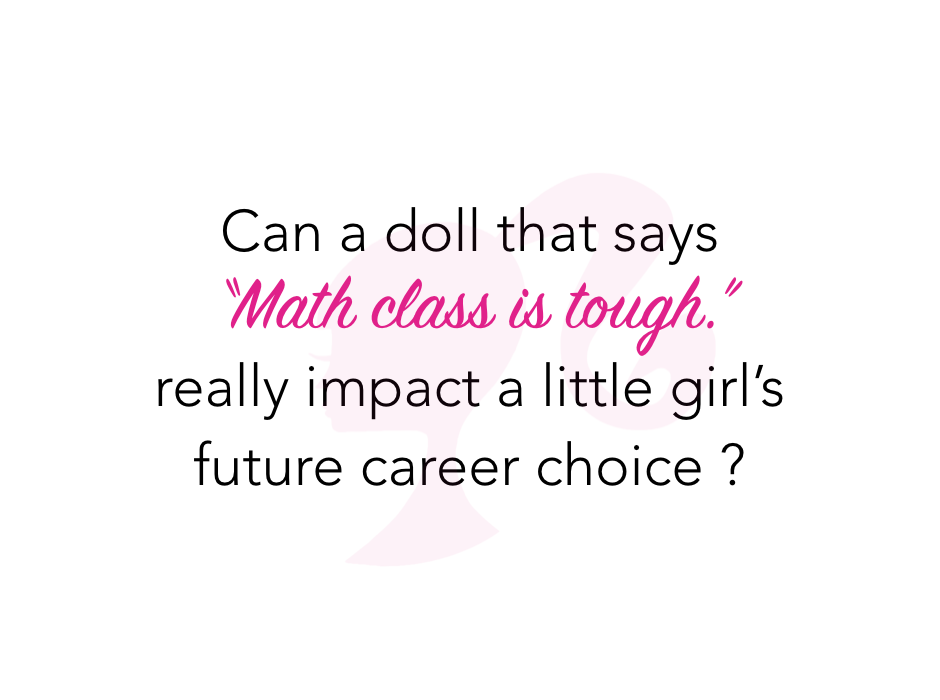
So…
Back to our original question.
Can a doll that says “Math class is tough” really impact little girls?
[ASK THE AUDIENCE — “Raise hand if yes”, “Raise hand if no”]
The answer is maybe. Perhaps a little girl hears that phrase and loses confidence in her ability to do math which leads to a rejection of any field she or society associates with math. Or she hears that phrase and it does nothing to her self efficacy at all. Either could be true. Sapna Cheryan is an associate professor of psychology at the University of Washington researching stereotypes that contribute to male-dominated science and technology fields and is also a member of the Barbie Council. In an article she states “whether a Barbie dressed as a robotics engineer can influence a girl’s future career choice remains to be seen.” However she also says “We need to broaden the images of different fields by showing different examples: different role models, environments and portrayals in the media…considering the reach Barbie has, why not try?”
So in this same vein, if there’s even a small chance that hearing “math class is tough” could completely turn a girl away from pursing computer science or engineering, why not try to be better? And I believe Barbie has done better.

